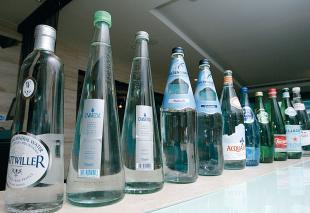

Will the water bubble burst?

In many restaurants, customers will examine the food and wine menu without giving a second thought to their water selection.
The choice however, has increased dramatically since the 1980s, when Evian and Perrier dominated a relatively new market.
Brands like San Pellegrino and Ferrarelle are now fighting traditional names for market dominance, while local brands swamp the region’s supermarkets and vending machines.
Chris Baker from the Harbour Hotel and Residence in Dubai Marina is one of the few executive chefs challenging customer perceptions by offering a broader range of bottled waters and training staff to understand the differences in taste and quality.
He has constructed an extensive water menu for the property’s Mediterranean restaurant Az.u.r.
“The market has changed from the old days, when the choice was between sparkling and still,” sayd Baker. “If a customer wants something light with a salad or a bit heavier for steak then that water is available to them.
“When you tell people we are comparing food with water they sometimes think we’re stupid but when they try one that matches their meal perfectly they begin to understand the potential,” he adds.
Michael Mascha, founder of the website finewaters.com, has written a book on the subject entitled Fine Waters: a connoisseur’s guide to the most distinctive bottled waters.
“At first glance, waters may not seem to have the individual characteristics that distinguish wines,” says Mascha. “But distinct differences become apparent when you focus on different bottles.
“Customers want a higher level of attention paid to the selection of bottled water available at establishments; still or sparkling just doesn’t cut it any more,” he adds.
Making a splash
In the same way that a wine’s quality can be determined by the soil a grape vine is grown in or by the shape of the surrounding valley, many bottled waters come with specific characteristics that make them stand out.
Berg, a Canadian brand of water, is the product of an Arctic iceberg. According to Mascha it is “a very soft water with a super-low mineral content and a great story to tell”.
Peteroa 9500 also captures the imagination - it is bottled at the source following a 9500 year underground journey through the limestone caves and caverns of the Andes mountain range in Chile. Mascha describes it as “a vintage with a low mineral content”.
Another bottled variety that will get tongues waging around any restaurant table is the Australian Cape Grim, a product consisting of rainwater captured on the north-western Tasmanian coast. Mascha says Cape Grim comprises soft and neutral qualities, adding that it is well presented and “perfect for the most subtle dishes”.
Water sommeliers
The Harbour Hotel’s Chris Baker is keen to educate both his staff and customers on the different varieties available at his restaurants and asserts that water can compliment both the food and wine selection.
“If you are drinking a flat wine you may want a slightly sparking water to clear your palate between courses,” he explains.
“Alternatively, a flat and light bottled water compliments a very fizzy champagne as you would not want your mouth to overreact with the bubbles.”
Baker has held several training sessions with his staff from the hotel’s F&B outlets, in a similar vein as a wine tasting session.
“It’s taken a while for the education to come through but now we’re talking to our staff about which minerals are coming through or how much sodium is in there; suddenly they are realising they like certain waters,” comments Baker.
“This information can then be passed on to the customer in a similar way as wine knowledge or food recommendations.”
Bottling the image
Image is always important in marketing and visually striking bottles and labelling are key factors in the growth of the bottled water market.
Asker P K from International Hotel Supplies, a company supplying Hildon Natural Mineral Water to hotels and restaurants, says heavy marketing and naming bottled water after natural springs has proved popular with customers.
“Hildon attempts to display the exclusivity it merits and the product is widely used in most of the Sheikh Palaces in the UAE,” he says. “This has led to changes in the design of Hildon’s bottles and labels - and the material of Hildon’s bottle has changed to meet the needs of today’s customers.”
Linking the product to other popular beverages can also help its image.
JM Foods supplies Spayside Glenlivet to five-star hotels. “We decided to look for something unique when looking for our bottled water offerings,” says general manager Robert Mitchell:
“Spayside Glenlivet is sourced near many distilleries of well-known brands of Scotch malt whisky and one ingredient that makes the whisky so special is the purity of the water.”
Bubbling climate
As for the environmental impact of importing various bottles from across the world to the region, the Harbour Hotel’s Baker argues: “In an ideal world we wouldn’t bring the beef in from South Africa or organic chickens from Portugal because it would all be done here - but it isn’t and the ships are going to come in with or without our order.
“What we try to do is offset our footprint as much as we can.”
San Pellegrino’s marketing director Fausto Tazzi adds that “discerning customers demand the most from products and brands they indulge in; they will not accept any compromises”.
So while that debate rages on and the bottled water industry continues to diversify, is the region’s F&B industry justified in fuelling the trend?
Baker concludes: “At the end of the day the bottle water market is essential to us. You have two sets of people in Dubai, the tourist or the ex-pat — and most of them will not drink tap water no matter how safe you tell them it is.”